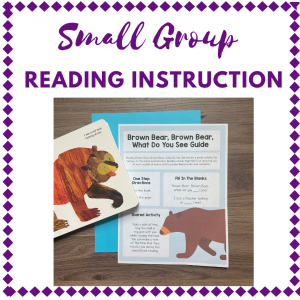
Brown bear, brown bear, what do you see? Many of us are familiar with this line from a well-known children’s book. Reading books can be a great activity to engage students, but we sometimes need fresh new ideas on how to better utilize them in targeting different goals in therapy and small group reading instruction. Small group reading instruction may be integrated into speech-language therapy sessions to aide in improvement of literacy abilities.
We are always in search of resources that are functional for students with a variety of different needs. To help with this, ABA Speech is excited to offer a fun and engaging book companion! Book companions are a great resource to work on joint attention and to embed literacy during therapy sessions, small group reading instruction, and/or in the home environment. They can easily be used by parents, speech-language pathologists, teachers, and others to aide in engaging with the student. Book companions provide an easy lesson plan to guide therapy sessions and small group reading instruction, allowing us to engage with children and target goals more efficiently and effectively. Book companions are adaptable and can easily be adjusted for all communication levels and needs!
Get Your Freebie
Make sure to scroll down to the bottom and put your email in to get your free Brown Bear companion.
Why use books in therapy?
What is literacy-based intervention, and how is it effective? Literacy-based intervention is evidence-based and often highly effective in therapy and small group reading instruction. This type of instruction aides in the development of literacy skills through having literary experiences with books. According to Goldstein, et al (2017), “Children who do not develop early literacy skills, especially phonological awareness and alphabet knowledge, prior to kindergarten are at risk for reading difficulties.” Through literature-based intervention, learners can attain many skills such as exposure to new vocabulary and concepts as well as opportunities to practice and build sequencing skills and improve comprehension skills. Books and book companions not only support interactions with children but also provide opportunities to stimulate language development. When selecting books to use in therapy and/or small group reading instruction, intervention should be based on the learner’s developmental level, while also taking chronological age into consideration.
What goals can I support?
In therapy and in small group reading instruction, a variety of goals may be addressed. What goals and functional skills can book companions support? The opportunities are endless, but I would like to share a few ideas with you! One skill/goal in which they support involves providing an opportunities to target following 1-step directions (i.e. “Get the book,” “Turn the page,” and/or “Fill in the blanks” (Brown bear, brown bear, what do you ____?” “I see a teacher looking at ___.”) As learners acquire the ability to successfully follow 1-step directions, the level of complexity may be adjusted to target following multi-step directions. Practice with following directions can be helpful with all students but especially those with pre-academic needs. Book companions also help facilitate social engagement which, in turn, aides in building the foundation for more advanced conversational skills. In addition, they are a great resource for shared activities which helps parents, speech-language pathologists, and others to better engage with children who are working on shared reading and shared group activities. They can also help provide opportunities to obtain baseline data for the duration in which a student is able to engage. This can be helpful with increasing on-task duration so the learner(s) can improve in the ability to enjoy shared activities with classmates and peers. As I mentioned before, there are numerous ways to utilize book companions!
Get your book companion
We hope you enjoy using our new book companion in your therapy sessions, in small group reading instruction, and even at home! Be sure to scroll down to the bottom, and input your e-mail to get your free Brown Bear, Brown Bear book companion! This is the perfect supplement to ease your planning for teletherapy, in-person, mixed level groups, all ages, and small group reading instruction!
Goldstein et al. (2017). Efficacy of a Supplemental Phonemic Awareness
Curriculum to Instruct Preschoolers With Delays in Early Literary
Development. J Speech Lang Hear Res. Jan; 60(1): 89-103.

What other book would you suggest for a small group read out loud for children with Autism?
I also love Pete the Cat and His White Shoes, I went walking and Chicka Chicka Boom Boom.
what other sensory activities would you suggest for toddles with Autism?
Hi Linda. Please register for my upcoming live webinar all about autism speech therapy strategies for toddlers and preschool aged students:
https://abaspeech.org/webinar-autism-strategies/